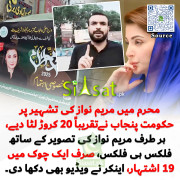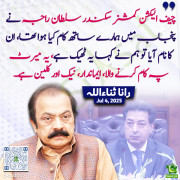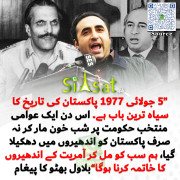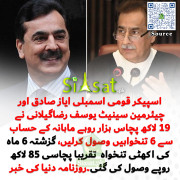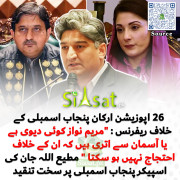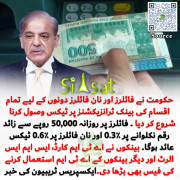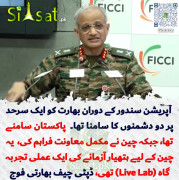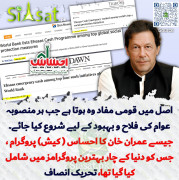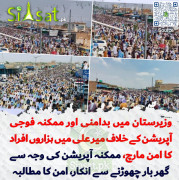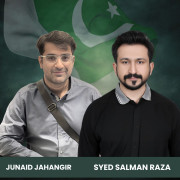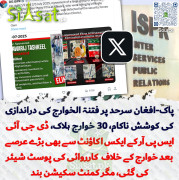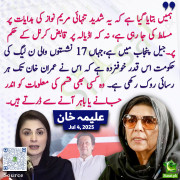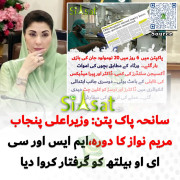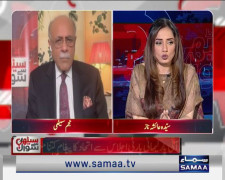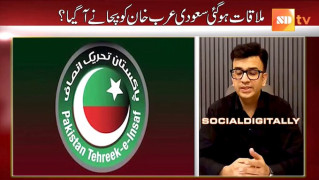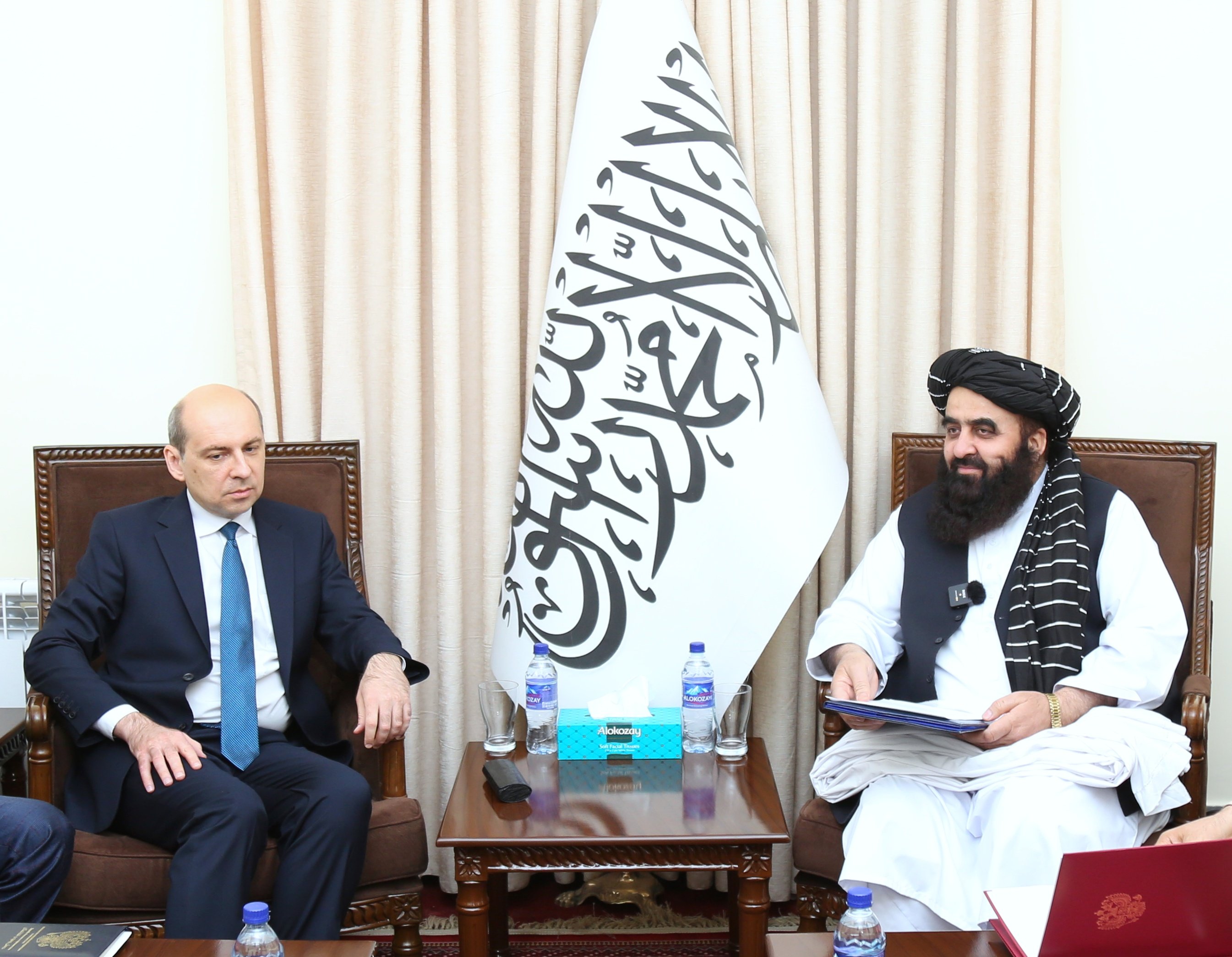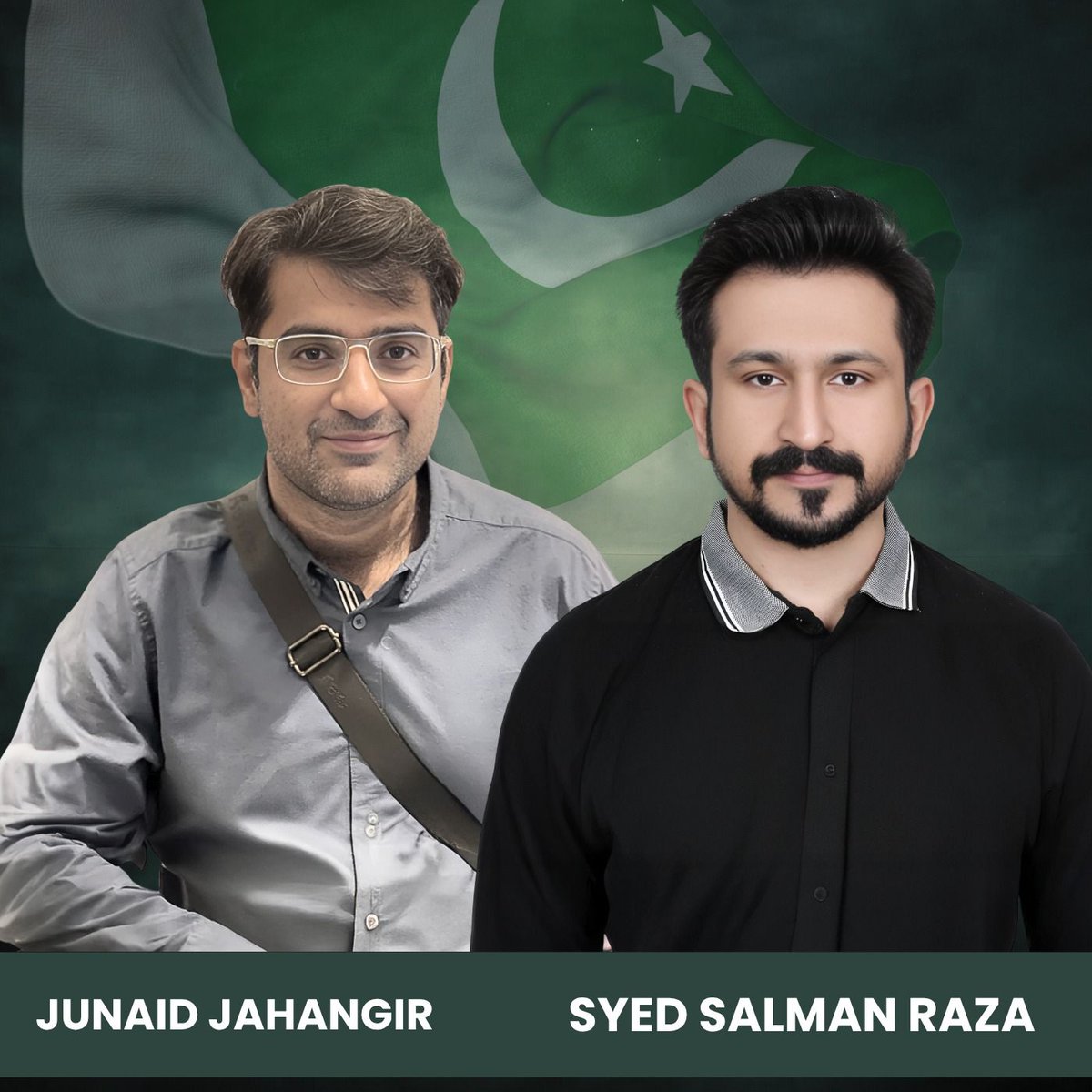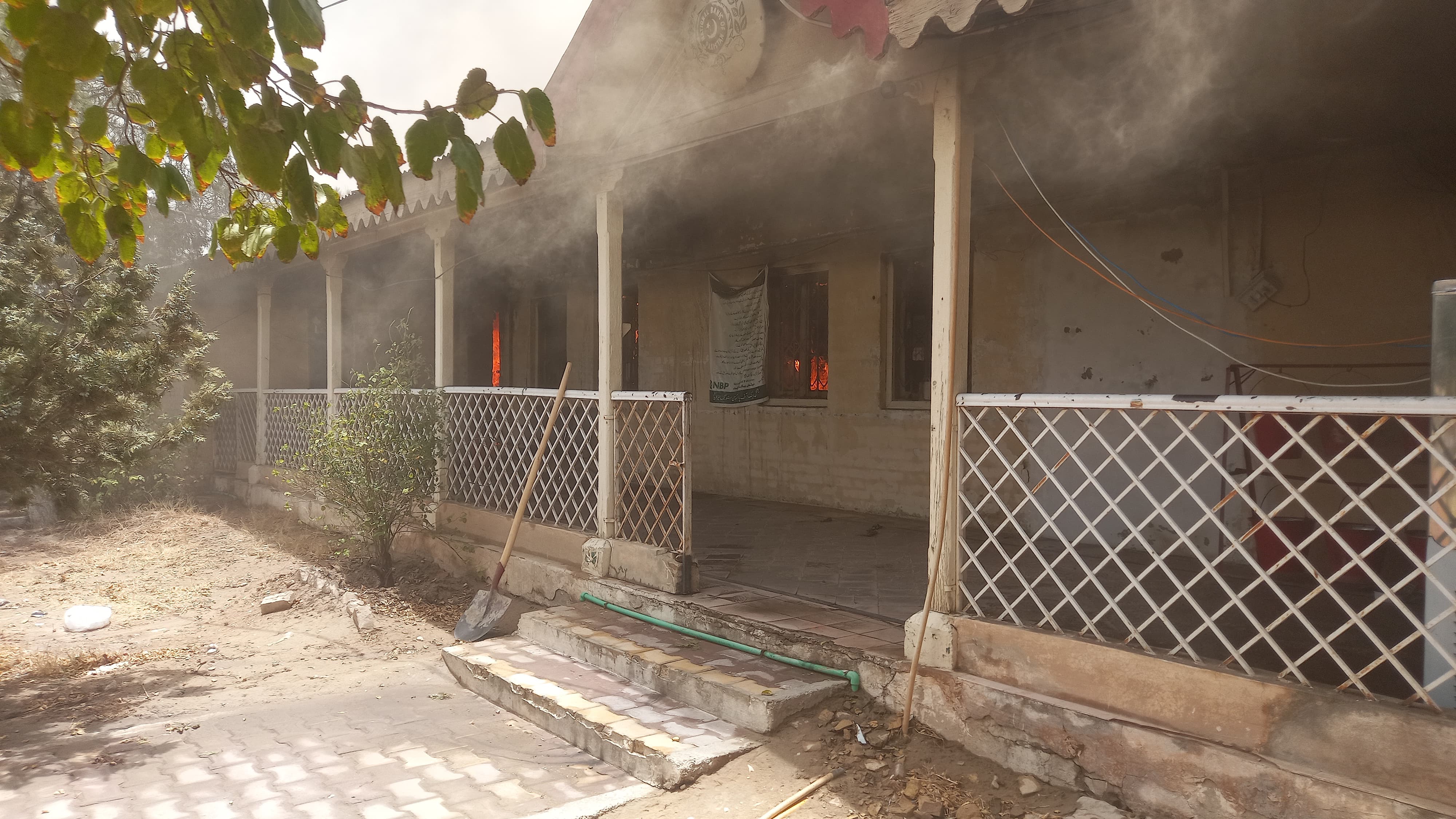You are using an out of date browser. It may not display this or other websites correctly.
You should upgrade or use an alternative browser.
You should upgrade or use an alternative browser.
For Imran Khan PTI
- Thread starter Jury
- Start date
1986
MQMs first-ever public meeting at Karachis Nishtar park on August 8, 1986, was marked by heavy aerial firing from the; pistols and rifles which the party activists were carrying on them. On that day, windowpanes of a traffic police kiosk opposite Quaid-e-Azams mausoleum were broken, and stones were pelted on petrol pump near Gurumandir. Addressing the rally, Altaf Hussain said: Karachi is no more mini-Pakistan. We will accept help no matter where it comes from, from east or west, north or south (dailies Jang, Jasarat and other newspapers of August 9, 1986).
Two months later, on October 25, 1986, while addressing a press conference at Hyderabad Press Club, Altaf Hussain told the Mohajir youth to collect arms. If our rights are not given to us, we will use every kind of force. On October 31, while addressing a public meeting at Hyderabads Pakka Qila, he said: At first we fought for freedom. Now that we have freedom, we are searching for a country (daily Amn, Nov 1, 1986). Riots broke out in Karachi the same evening. Twelve persons were killed, 25 wagons, autorickshaws and motorbikes were set on fire, and four houses and eight shops were torched.
Riots spread to Hyderabad where seven persons were shot dead in two days. Curfew was clamped in both cities to contain violence, and Altaf Hussain alongwith ten others was arrested by he police on November 2 for attempt to murder and rioting. Nine other MQM activists were also taken into custody and firearms recovered from their possession, whereas 63 persons from other parties to the rioting were arrested from Sohrab Goth area. On November 3, ten persons were killed in hand-grenade attacks in Orangi Town area while six others died in street trouble, brining the weeks death toll in Karachi to 52.
On November 18, armed MQM activists fired in the air to disrupt a cricket match in Hyderabads Niaz Stadium. On November 21, at the end of a one-day cricket match between Pakistan and West Indies, armed MQM activists blocked all roads leading to Karachis National Stadium. 30 persons received bullet wounds in indiscriminate firing in the Liaquatabad. Teen Hatti, Gulbahar, Orangi, Sabzi Mandi, Nazimabad and other areas of the city. A bank was burnt in Liaquatabad, while a bus was put on fire on Shahrah-e-Quaideen. One November 22, three buses and an oil tanker were burnt in Landhi, while a branch of the National Bank was ransacked and torched in Liaquatabad.
Another government bus and a minibus were burnt in Malir and Old Numaish, and several buses were pelted with stones on November 23. On November 24, 11 vehicles were burnt down in New Karachi, Federal B Area, Paposhnagar, Gulbahar and Nasirabad. On November 28, armed clashes between MQM activists and the police took place in Hyderabad during which five bank branches were damaged and one bus put on fire.
MQM announced a strike in Karachi on December 9 and asked its followers to remain peaceful. The peaceful strike led to the burning of 11 vehicles and seven bank branches. One youngster was killed, and nearly 40 wounded in indiscriminate firing. Demonstrators pelted stones on the police and a bomb was blasted near Liaquatabad police station. The police became helpless against protesters (daily Amn). On December 14, MQMs secretary general Dr Imran Farooq stated that the situation could be brought under control only if Altaf Hussain and his companions were freed.
That night, 50 persons lost lives during ghastly manslaughter in Orangi Town. The army was called in and curfew clamped. According to newspapers, the entire Ghetto Township had passed into the hands of a group of klashnikov-weilding youngsters. 70 more persons were killed on December 15.
According to available statistics, as many as 173 persons were sacrificed on the alter of MQM struggle for rights, while 10 banks, 75 vehicles 24 houses and 20 shops were burnt during the last 153 days of 1986. The battle for Karachis so-called rights had begun. On December 20, MQM Chairman Azim Ahmad Tariq demanded justice for Mohajirs, and advised President Zia-ul Haq to issue arms licenses to Mohajirs. After this, we will neither invite the police or the administration to defend us, nor criticize the government on this score (daily Jang Karachi).
1987
With the onset of 1987, lawlessness in Karachi caused curfew for a record number of days. This was also the year when MQMs anti-press traits began to shape up. The coming days were to expose some of the most fundamental contradictions inherent in the partys structure and philosophy.
It was on January 31, when Altaf Hussain made the first most controversial public statement of his career. Addressing a series of welcome receptions in Liaquatabad on that day, he told his audience. Mohajirs will have no god use for their VCRs, color televisions and other luxuries because these things cannot defend us. They will have to arrange for their own security (daily Jang, Feb 1, 1987).
On February 1, in the central committee meeting of Awami National Party at Lahore that was presided by Khan Abdul Wali Khan, a resolution was passed stating that Sindhs Mohajirs were a part of the larger Sindhi nationality, and that there was no such thing as a Mohajir nationality. ANP was later to become one of MQMs most trusted allies in national politics.
On February 19, Altaf Hussain addressed another rally at Burns Road in Karachi. As the party activists started shooting their guns in the air, Altaf Hussain stopped them, saying save your ammunition. The audience raised hands to give Altaf the permission to meet anyone, including G.M. Syed. During his address, Altaf said that Sindh could not bear any more population. There are also Lahore and Faisalabad in the way. These too are Pakistani cities.
On February 20 and 21, 16 persons were wounded and one Suzuki van, four motorbikes and a KTC bus were put on fire during rioting in Liaquatabad, Shershah, Federal B Area and Sabzi Mandi. Young boys in Liaquatabad pelted stones at the police the whole day.
On April 5, at the book launching ceremony of Shakil Ahmad Zia, Altaf made a hard hitting speech against Punjab, the Punjabis and the army. You used force, and the result was that the country broke into two History offers no example of such a large number of troops laying down arms. For those who want to send us back to India, let me say that we will not go alone. The whole Pakistan will go to India. During the same address he issued his first threat to the press. One newspaper is becoming a party against Mohajirs. It should take warning (daily Amn. April 6, 1987).
On May 21, a young man was killed when riots broke out in Malir and Khokhrapar in protest over the arrest of some MQM workers. Six vehicles were also burnt in the area.
In an interview with daily Nawa-e-Waqts Irashad Ahmad Arif, published on May 25, 1987, Altaf Hussain said: Urdu language is Punjabs problem, not ours. We have never demanded that it should be made the national language.
On June 11, while addressing the foundation day celebrations of All-Pakistan Mohajir Students Organisation (APMSO), he demanded that Mohajirs be issued with arms licenses. He said the religious parties did nothing for the Mohajir Shaheeds but when a Punjabi died everyone from top issued statements of condemnation to bottom. He also said that anyone who met the Muslim Leaguers or was hand in glove with the government ministers had no place in MQM ranks (daily Amn, June 12, 1987).
On June 21, MQM chairman, Azim Ahmad Tariq, stated that the anti-Mohajir policy of daily Jang would be fully resisted. He announced Jangs boycott, and asked people not to read it. The same evening, dozen-armed persons attacked Jangs bureau in Hyderabad and put the premises on fire.
From July 22 to August 30, clashes between MQM and a rival group called Punjabi-Pukhtoon Ittehad (PPI) caused the death of 22 persons, while 300 were wounded. Five policemen also died in riots, while 38 were wounded. Seven KTC buses and a local train also became targets of terrorism. Clashes between the two rival groups had first broken out in April, but arrests on both sides had caused the trouble to temporarily subside.
On August 4, during an address to MQMs general workers meeting, Altaf Hussain said that the days of the power of the army and the police were numbered. These forces have been bullying us in our airfields, police stations, neighborhoods and streets. They have put the entire Pakistan in their pockets. He further said on August 14, MQM would announce that mini-Pakistan is not Karachi, but Lahore. Throw open the gates of Lahore to Afghan refugees on that day, and let them do what they please (daily Amn, August 5, 1987).
On August 9, the campaign to collect sacrificial hides began in Karachi and Azim Tariq, in a statement, alleged that the Jamaat workers robbed MQM volunteers of their hides at gunpoint. He condemned this act, and issued a warning to Jamaat. On August 21, Altaf Hussain told a meeting at New Karachi that the problems could no longer be solved without rendering sacrifices, and asked people willing to make sacrifices to give their names. Addressing the Mohajir police trainees, he said that if they are forced to quit their job, they should break the legs of their instructor. A time will come when our people will be sitting in police stations he said.
On August 26, bloody-armed clashes between two groups in Shah Faisal Colony led to the death of nine persons. 80 persons were injured. Eight platoons of police, riding in 32 mobile vans, were present at the scene but could not bring hostilities to an end. Riots also broke out in Hyderabad on August 27. Curfew was clamped which continued unbroken for twelve days, until 4 p.m. on September 7. On August 28, chairman Jiye Sindh Mahaz (JSM), Abdul Wahid Aresar, expressed support for the suppressed Mohajirs, saying that the army, the police and Punjabi settlers had attacked the Mohajirs as if they were a conquered people (daily Amn, August 29, 1987).
The government of Sindh on August 28 issued orders for the arrest of all those involved in rioting. PPIs Malik Ghulam Sarwar Awan, Mir Hazar Khan and 160 others were arrested, but Altaf Hussain was not found at his residence.
In the interest of peace, the government made a goodwill gesture by dropping criminal charges against all concerned, but it was not destined to work.
On August 30, Altaf Hussain courted arrest. On September 29, a spokesman of MQM said that the party considered Khanabdul Wali Khan and Abdul Ghaffar Khan as the true representatives of the Pukhtoons. He also expressed optimism about the partys ongoing talks with the PPI.
On October 8, G.M. Syed told journalists in Matli that the time had come for a union between the Sindhis and Mohajirs. We have recognized our common enemy, he said.
On October 31, MQM announced a strike to commemorate last years killings at Sohrab Goth. During the strike, indiscriminate firing led to the killing of two persons. 85 others were injured while six vehicles, seven shopsand two banks were put on fire. A telephone exchange was burnt in Orangi. Three women, a girl and a man were injured in roadside firing in Liaquatabad and a petrol bomb in Pak Colony injured two police constables. Riots in Kotri and Hyderabad resulted in injuries to DSP and SSP Hyderabad, while offices of the Muslim League and Wapda, a post office, an office of social security, four bank branches and 17 vehicles were set on fire.
1988
Rioting, arson and murder continued into January 1998, ten months before the restoration of democracy in the country. On January 10, stabbing incidents and acts of terrorism in Golimar, Liaquatabad, New Karachi Shah Faisal Colony, Banaras, tin Hatti, Chand Bibi Road and Rizvia Society led to the killing of five persons, and the injuring of several pedestrians including three journalists. 13 vehicles were also set on fire. The army was called in to control the situation. On January 18, four persons were killed in bloody clashes between MQM and PPI activists. Moreover, 37 houses and shops of the area were put on fire in petrol bomb attacks. Curfew was clamped to disengage the warring factions.
Nine persons were killed and 60 hurt in riots that engulfed Nazimabad, Liaquatabad and Sohrab Goth on February 4. The property put on fire included 28 houses, several shops, two factories, a petrol pump and several vehicles. Six more people were killed, and two vehicles burnt, in Liaquatabad, Pak Colony and Gulbahar areas on February 8. Curfew continued in different areas of the city. In a statement on February 21, Altaf Hussain said that Jamaat-e-Islami was another name for the drug mafia and the police. He called Jamaats Prof. Ghafoor a liar, and accused him of towing Jamaats traditional policy of hypocrisy (daily Amn, Feb 22, 1988).
On March 1, the driver of an oil tanker lost control when he came under attack of rioters in Liaquatabad, the vehicle breaking into a house and killing four inmates. This incident was followed by violent protest in which rioters injured 12 policemen including SDM and DSP Liaquatabad. Nine police vans, a minibus and an autorickshaw were damaged. Four more vehicles were put on fire. On March 3, curfew was clamped in Liaquatabad to prevent further trouble. On March 13, in his address to the Karachi bar, Altaf Hussain advised Punjabis and Pukhtoons to go back to their own provinces and demand jobs from their governments.
On April 6, an attempt by the MQM to rename Haider Chowk (named after great nationalist leader, Comrade Haider Bux Jatoi) as Mohajir Chowk created tension in Hyderabad.
On April 30, an accident between a motorbike and a Suzuki van led to incidents of stabbing and firing in Orangi in which four persons were killed.
10 injured a bank branch and several shops burnt. The trouble spread, and by May 9, 31persons had fallen to death in factional fights in Orangi, Nishtar Road, Lighthouse, Pak Colony, Khwaja Ajmer Nagri, Nazimabad and elsewhere.
On May 11, the incidents of stabbing rickshaw drivers in the curfew hit areas started. Six rickshaw drivers were seriously injured. On May 23, MQM activists hiding in Jutland Lines and Shah Faisal colony started attacking policemen and magistrates in order to harass them.
On June 18, riots broke out in Hyderabad in which six persons died and 12 vehicles were destroyed. Two more persons died on the following day inspite of the imposition of curfew.
July 17, in the riots following attack on Mayor Hyderabad. Aftab Shaikh, eight persons were killed and much damage done to property. The bodies of the victims were sent to Sindh interior. On July 21, women activists of MQM stormed the Latifabad police Station and freed 18 arrested persons. G.M. Syed told newsmen on July 22 that both the government and Altaf Hussain were responsible for the deteriorating law and order situation. Altaf Hussain had become arrogant, inflated, he said. On the following day, altaf Hussain called on Syed at Haider Manzil and the two leaders made and remove misunderstandings.
On August 30, MQM activists pumped bullets into a Karachi University student, Aamir Salim, killing him instantly. On September 3, APMSO activists launched attacks on members of other student bodies as well as on lecturers in various city colleges, injuring dozens of them. These attacks were supervised by five councilors of the municipality. On September 30, the worst carnage of Hyderabads history took place in which more than 150 persons, including Urdu speaking, Gujratis, Sindhis and Memons were killed.
On the following day, i.e. on October 1, terrorists in an early morning operation in Karachis suburban areas of Landhi, Malir, Shah Faisal Colony, Model Colony, Gulbahar, Orangi Town and Pak Colony herded out of their houses and shot dead at least 90 Sindhi persons. Chief of Mohajir Ittehad Tehrik (MIT), Dr Salim Haider, in a statement said that MQM had given nothing to the people but dead bodies.
On November 10, a representative meeting of the political parties of Karachi condemned MQMs terrorism, and in this regard a memorandum for Commissioner Karachi was signed by PPPs Amir Haider Kazmi, ANPs Amin Khatak, PDPs Mushtaq Mirza, JUIs Qari Sher Afzal and others. Maulana Shah Ahmad Noorani stated that MQM wanted to win elections by terrorizing the people, but we will not bow before anyone.
1989
This was the year when incidents of firing by masked assailants increased, differences within the MQM came to surface, and thousands of copies of Urdu daily Jang were burnt by MQM activists during a boycott of that newspaper.
The rioting that marred the last days of 1988 continued into the New Year with the death of a man on January 1, 1989. This led to the arrest of 72 PPI activists, and cases were registered against one MNA and two MPAs of MQM for inciting trouble. January 24 and 26, MQM forced the closure of all markets and bazaars in Sukkur. On January 30, armed bands of MQM activists took control of the NED Engineering University. On January, curfew was clamped in some parts of the Karachi port following the murder of a taxi driver in the area.
On February 23, arsonists torched the offices of the vice chancellor of Karachi University. After day long rioting, the university was closed indefinitely.
On March 10, a 16-year-old person died and about twelve others were hurt as a result of indiscriminate firing by terrorists on innocent pedestrians. On the same day MQM announced its boycott of Jang newspaper.
On March 11, four dead bodies were recovered from Model Colony area. On March 12, curfew was imposed in Shah Faisal Colony following the death of a 12-year-old child. 13 persons were inured in terrorist firing on March 13. On March 14, two dead bodies were recovered in the wake of ongoing trouble in Shah Faisal colony and Saudabad. Masked gunmen struck on March 18, killing 10 persons and wounding 15 as they went on a killing spree in Malir and Khokhrapar areas. On March 22, MQM members together with G.M. Syeds son, Imdad Mohammad Shah, staged a protest walkout from Sindh Assembly. On March 26, MQM announced that it would back the IJI for the repatriation of Biharis from Bangladesh.
On April 1, three people died in firing by masked gunmen in Shah Faisal Colony. Student trouble started in the two medical colleges of the city and 10 students were kidnapped from Karachi University. On April 6, 10 persons were killed and 40 others wounded in incidents of firing in Hyderabad. The trouble was controlled by imposition of curfew. While death and destruction reigned in Karachi and Hyderabad. Curfew was also imposed in Nawabshah following the death of five persons in linguistic riots.
Three MQM ministers filed their resignations on May 1, but the government as a goodwill gesture rejected these. On May 3, the MQM activists broke up a rally of JUP in Gulbahar at which Maulana Shah Ahmad Noorani was the chief guest. On May 7, a government contractor was killed in Ranchore Line. On May 9, doctors lodged their protest over the activities of armed MQM activists inside Civil Hospital Karachi. In Sukkur, 20 shops were burnt down in linguistic riots. Medical examinations were postponed on May 18 following an armed clash of APMSO with Sindhi students.
MQM announced its campaign of voluntary arrests to protest against the government on May 26. Talks between the chief minister Punjab, Mian Nawaz Sharif, and Altaf Hussain for political co-operation were held on May 30. On June 1, three federal ministers held an emergent round of talks with the MQM in order to save the Karachi accord.
On June 14, a group of armed students stormed the university offices and held the vice chancellor and 20 staff members hostage for eight hours.
Three Peoples Students Federation (PSF) workers were killed on July 8. Between July 16 and 23, widespread trouble in Hyderabad led to the death of 10 persons. Curfew was imposed in the city.
On August 13, following the killing of seven persons in firing by masked gunmen, certain areas of Karachi were again brought under curfew. Armed persons also gunned down 11 more persons died in riots on August 19, a police constable was gunned down.
Between September 17 and 19, at least nine people were killed and 24 injured in riots in Hyderabad. On September 21, a student was killed and three others injured in firing in Karachis S.M. Science College. In Model Colony, day long rioting and running gunbattles led to the imposition of curfew. In a report submitted on September 22, the then DIG Karachi, Afzal Shigri, said that MQM was not a political organization, but a terrorist one.
Altaf met President Ghulam Ishaq Khan at Karachis State guesthouse on October 13. On the same day, two police inspectors were gunned down by terrorists in the city. On October 23, MQM unilaterally pulled out of Karachi accord.
Violence hit Karachi and Hyderabad on November 6, in which four persons were killed. The then chief of army staff, Mirza Aslam Beg, expressed hope on November 7 that soon a broad based government would be established in the country. Rangers were called to Soldier Bazaar on November 9 following the death of one person in firing. On November 21, a man was killed in Baldia town.
On December 2 an armed clash between students of Dow Medical College resulted in injuries to 12 students. Meanwhile, five days of rioting in Hyderabad between December 12 and 25 resulted in the death of 21 persons. Five pe
MQMs first-ever public meeting at Karachis Nishtar park on August 8, 1986, was marked by heavy aerial firing from the; pistols and rifles which the party activists were carrying on them. On that day, windowpanes of a traffic police kiosk opposite Quaid-e-Azams mausoleum were broken, and stones were pelted on petrol pump near Gurumandir. Addressing the rally, Altaf Hussain said: Karachi is no more mini-Pakistan. We will accept help no matter where it comes from, from east or west, north or south (dailies Jang, Jasarat and other newspapers of August 9, 1986).
Two months later, on October 25, 1986, while addressing a press conference at Hyderabad Press Club, Altaf Hussain told the Mohajir youth to collect arms. If our rights are not given to us, we will use every kind of force. On October 31, while addressing a public meeting at Hyderabads Pakka Qila, he said: At first we fought for freedom. Now that we have freedom, we are searching for a country (daily Amn, Nov 1, 1986). Riots broke out in Karachi the same evening. Twelve persons were killed, 25 wagons, autorickshaws and motorbikes were set on fire, and four houses and eight shops were torched.
Riots spread to Hyderabad where seven persons were shot dead in two days. Curfew was clamped in both cities to contain violence, and Altaf Hussain alongwith ten others was arrested by he police on November 2 for attempt to murder and rioting. Nine other MQM activists were also taken into custody and firearms recovered from their possession, whereas 63 persons from other parties to the rioting were arrested from Sohrab Goth area. On November 3, ten persons were killed in hand-grenade attacks in Orangi Town area while six others died in street trouble, brining the weeks death toll in Karachi to 52.
On November 18, armed MQM activists fired in the air to disrupt a cricket match in Hyderabads Niaz Stadium. On November 21, at the end of a one-day cricket match between Pakistan and West Indies, armed MQM activists blocked all roads leading to Karachis National Stadium. 30 persons received bullet wounds in indiscriminate firing in the Liaquatabad. Teen Hatti, Gulbahar, Orangi, Sabzi Mandi, Nazimabad and other areas of the city. A bank was burnt in Liaquatabad, while a bus was put on fire on Shahrah-e-Quaideen. One November 22, three buses and an oil tanker were burnt in Landhi, while a branch of the National Bank was ransacked and torched in Liaquatabad.
Another government bus and a minibus were burnt in Malir and Old Numaish, and several buses were pelted with stones on November 23. On November 24, 11 vehicles were burnt down in New Karachi, Federal B Area, Paposhnagar, Gulbahar and Nasirabad. On November 28, armed clashes between MQM activists and the police took place in Hyderabad during which five bank branches were damaged and one bus put on fire.
MQM announced a strike in Karachi on December 9 and asked its followers to remain peaceful. The peaceful strike led to the burning of 11 vehicles and seven bank branches. One youngster was killed, and nearly 40 wounded in indiscriminate firing. Demonstrators pelted stones on the police and a bomb was blasted near Liaquatabad police station. The police became helpless against protesters (daily Amn). On December 14, MQMs secretary general Dr Imran Farooq stated that the situation could be brought under control only if Altaf Hussain and his companions were freed.
That night, 50 persons lost lives during ghastly manslaughter in Orangi Town. The army was called in and curfew clamped. According to newspapers, the entire Ghetto Township had passed into the hands of a group of klashnikov-weilding youngsters. 70 more persons were killed on December 15.
According to available statistics, as many as 173 persons were sacrificed on the alter of MQM struggle for rights, while 10 banks, 75 vehicles 24 houses and 20 shops were burnt during the last 153 days of 1986. The battle for Karachis so-called rights had begun. On December 20, MQM Chairman Azim Ahmad Tariq demanded justice for Mohajirs, and advised President Zia-ul Haq to issue arms licenses to Mohajirs. After this, we will neither invite the police or the administration to defend us, nor criticize the government on this score (daily Jang Karachi).
1987
With the onset of 1987, lawlessness in Karachi caused curfew for a record number of days. This was also the year when MQMs anti-press traits began to shape up. The coming days were to expose some of the most fundamental contradictions inherent in the partys structure and philosophy.
It was on January 31, when Altaf Hussain made the first most controversial public statement of his career. Addressing a series of welcome receptions in Liaquatabad on that day, he told his audience. Mohajirs will have no god use for their VCRs, color televisions and other luxuries because these things cannot defend us. They will have to arrange for their own security (daily Jang, Feb 1, 1987).
On February 1, in the central committee meeting of Awami National Party at Lahore that was presided by Khan Abdul Wali Khan, a resolution was passed stating that Sindhs Mohajirs were a part of the larger Sindhi nationality, and that there was no such thing as a Mohajir nationality. ANP was later to become one of MQMs most trusted allies in national politics.
On February 19, Altaf Hussain addressed another rally at Burns Road in Karachi. As the party activists started shooting their guns in the air, Altaf Hussain stopped them, saying save your ammunition. The audience raised hands to give Altaf the permission to meet anyone, including G.M. Syed. During his address, Altaf said that Sindh could not bear any more population. There are also Lahore and Faisalabad in the way. These too are Pakistani cities.
On February 20 and 21, 16 persons were wounded and one Suzuki van, four motorbikes and a KTC bus were put on fire during rioting in Liaquatabad, Shershah, Federal B Area and Sabzi Mandi. Young boys in Liaquatabad pelted stones at the police the whole day.
On April 5, at the book launching ceremony of Shakil Ahmad Zia, Altaf made a hard hitting speech against Punjab, the Punjabis and the army. You used force, and the result was that the country broke into two History offers no example of such a large number of troops laying down arms. For those who want to send us back to India, let me say that we will not go alone. The whole Pakistan will go to India. During the same address he issued his first threat to the press. One newspaper is becoming a party against Mohajirs. It should take warning (daily Amn. April 6, 1987).
On May 21, a young man was killed when riots broke out in Malir and Khokhrapar in protest over the arrest of some MQM workers. Six vehicles were also burnt in the area.
In an interview with daily Nawa-e-Waqts Irashad Ahmad Arif, published on May 25, 1987, Altaf Hussain said: Urdu language is Punjabs problem, not ours. We have never demanded that it should be made the national language.
On June 11, while addressing the foundation day celebrations of All-Pakistan Mohajir Students Organisation (APMSO), he demanded that Mohajirs be issued with arms licenses. He said the religious parties did nothing for the Mohajir Shaheeds but when a Punjabi died everyone from top issued statements of condemnation to bottom. He also said that anyone who met the Muslim Leaguers or was hand in glove with the government ministers had no place in MQM ranks (daily Amn, June 12, 1987).
On June 21, MQM chairman, Azim Ahmad Tariq, stated that the anti-Mohajir policy of daily Jang would be fully resisted. He announced Jangs boycott, and asked people not to read it. The same evening, dozen-armed persons attacked Jangs bureau in Hyderabad and put the premises on fire.
From July 22 to August 30, clashes between MQM and a rival group called Punjabi-Pukhtoon Ittehad (PPI) caused the death of 22 persons, while 300 were wounded. Five policemen also died in riots, while 38 were wounded. Seven KTC buses and a local train also became targets of terrorism. Clashes between the two rival groups had first broken out in April, but arrests on both sides had caused the trouble to temporarily subside.
On August 4, during an address to MQMs general workers meeting, Altaf Hussain said that the days of the power of the army and the police were numbered. These forces have been bullying us in our airfields, police stations, neighborhoods and streets. They have put the entire Pakistan in their pockets. He further said on August 14, MQM would announce that mini-Pakistan is not Karachi, but Lahore. Throw open the gates of Lahore to Afghan refugees on that day, and let them do what they please (daily Amn, August 5, 1987).
On August 9, the campaign to collect sacrificial hides began in Karachi and Azim Tariq, in a statement, alleged that the Jamaat workers robbed MQM volunteers of their hides at gunpoint. He condemned this act, and issued a warning to Jamaat. On August 21, Altaf Hussain told a meeting at New Karachi that the problems could no longer be solved without rendering sacrifices, and asked people willing to make sacrifices to give their names. Addressing the Mohajir police trainees, he said that if they are forced to quit their job, they should break the legs of their instructor. A time will come when our people will be sitting in police stations he said.
On August 26, bloody-armed clashes between two groups in Shah Faisal Colony led to the death of nine persons. 80 persons were injured. Eight platoons of police, riding in 32 mobile vans, were present at the scene but could not bring hostilities to an end. Riots also broke out in Hyderabad on August 27. Curfew was clamped which continued unbroken for twelve days, until 4 p.m. on September 7. On August 28, chairman Jiye Sindh Mahaz (JSM), Abdul Wahid Aresar, expressed support for the suppressed Mohajirs, saying that the army, the police and Punjabi settlers had attacked the Mohajirs as if they were a conquered people (daily Amn, August 29, 1987).
The government of Sindh on August 28 issued orders for the arrest of all those involved in rioting. PPIs Malik Ghulam Sarwar Awan, Mir Hazar Khan and 160 others were arrested, but Altaf Hussain was not found at his residence.
In the interest of peace, the government made a goodwill gesture by dropping criminal charges against all concerned, but it was not destined to work.
On August 30, Altaf Hussain courted arrest. On September 29, a spokesman of MQM said that the party considered Khanabdul Wali Khan and Abdul Ghaffar Khan as the true representatives of the Pukhtoons. He also expressed optimism about the partys ongoing talks with the PPI.
On October 8, G.M. Syed told journalists in Matli that the time had come for a union between the Sindhis and Mohajirs. We have recognized our common enemy, he said.
On October 31, MQM announced a strike to commemorate last years killings at Sohrab Goth. During the strike, indiscriminate firing led to the killing of two persons. 85 others were injured while six vehicles, seven shopsand two banks were put on fire. A telephone exchange was burnt in Orangi. Three women, a girl and a man were injured in roadside firing in Liaquatabad and a petrol bomb in Pak Colony injured two police constables. Riots in Kotri and Hyderabad resulted in injuries to DSP and SSP Hyderabad, while offices of the Muslim League and Wapda, a post office, an office of social security, four bank branches and 17 vehicles were set on fire.
1988
Rioting, arson and murder continued into January 1998, ten months before the restoration of democracy in the country. On January 10, stabbing incidents and acts of terrorism in Golimar, Liaquatabad, New Karachi Shah Faisal Colony, Banaras, tin Hatti, Chand Bibi Road and Rizvia Society led to the killing of five persons, and the injuring of several pedestrians including three journalists. 13 vehicles were also set on fire. The army was called in to control the situation. On January 18, four persons were killed in bloody clashes between MQM and PPI activists. Moreover, 37 houses and shops of the area were put on fire in petrol bomb attacks. Curfew was clamped to disengage the warring factions.
Nine persons were killed and 60 hurt in riots that engulfed Nazimabad, Liaquatabad and Sohrab Goth on February 4. The property put on fire included 28 houses, several shops, two factories, a petrol pump and several vehicles. Six more people were killed, and two vehicles burnt, in Liaquatabad, Pak Colony and Gulbahar areas on February 8. Curfew continued in different areas of the city. In a statement on February 21, Altaf Hussain said that Jamaat-e-Islami was another name for the drug mafia and the police. He called Jamaats Prof. Ghafoor a liar, and accused him of towing Jamaats traditional policy of hypocrisy (daily Amn, Feb 22, 1988).
On March 1, the driver of an oil tanker lost control when he came under attack of rioters in Liaquatabad, the vehicle breaking into a house and killing four inmates. This incident was followed by violent protest in which rioters injured 12 policemen including SDM and DSP Liaquatabad. Nine police vans, a minibus and an autorickshaw were damaged. Four more vehicles were put on fire. On March 3, curfew was clamped in Liaquatabad to prevent further trouble. On March 13, in his address to the Karachi bar, Altaf Hussain advised Punjabis and Pukhtoons to go back to their own provinces and demand jobs from their governments.
On April 6, an attempt by the MQM to rename Haider Chowk (named after great nationalist leader, Comrade Haider Bux Jatoi) as Mohajir Chowk created tension in Hyderabad.
On April 30, an accident between a motorbike and a Suzuki van led to incidents of stabbing and firing in Orangi in which four persons were killed.
10 injured a bank branch and several shops burnt. The trouble spread, and by May 9, 31persons had fallen to death in factional fights in Orangi, Nishtar Road, Lighthouse, Pak Colony, Khwaja Ajmer Nagri, Nazimabad and elsewhere.
On May 11, the incidents of stabbing rickshaw drivers in the curfew hit areas started. Six rickshaw drivers were seriously injured. On May 23, MQM activists hiding in Jutland Lines and Shah Faisal colony started attacking policemen and magistrates in order to harass them.
On June 18, riots broke out in Hyderabad in which six persons died and 12 vehicles were destroyed. Two more persons died on the following day inspite of the imposition of curfew.
July 17, in the riots following attack on Mayor Hyderabad. Aftab Shaikh, eight persons were killed and much damage done to property. The bodies of the victims were sent to Sindh interior. On July 21, women activists of MQM stormed the Latifabad police Station and freed 18 arrested persons. G.M. Syed told newsmen on July 22 that both the government and Altaf Hussain were responsible for the deteriorating law and order situation. Altaf Hussain had become arrogant, inflated, he said. On the following day, altaf Hussain called on Syed at Haider Manzil and the two leaders made and remove misunderstandings.
On August 30, MQM activists pumped bullets into a Karachi University student, Aamir Salim, killing him instantly. On September 3, APMSO activists launched attacks on members of other student bodies as well as on lecturers in various city colleges, injuring dozens of them. These attacks were supervised by five councilors of the municipality. On September 30, the worst carnage of Hyderabads history took place in which more than 150 persons, including Urdu speaking, Gujratis, Sindhis and Memons were killed.
On the following day, i.e. on October 1, terrorists in an early morning operation in Karachis suburban areas of Landhi, Malir, Shah Faisal Colony, Model Colony, Gulbahar, Orangi Town and Pak Colony herded out of their houses and shot dead at least 90 Sindhi persons. Chief of Mohajir Ittehad Tehrik (MIT), Dr Salim Haider, in a statement said that MQM had given nothing to the people but dead bodies.
On November 10, a representative meeting of the political parties of Karachi condemned MQMs terrorism, and in this regard a memorandum for Commissioner Karachi was signed by PPPs Amir Haider Kazmi, ANPs Amin Khatak, PDPs Mushtaq Mirza, JUIs Qari Sher Afzal and others. Maulana Shah Ahmad Noorani stated that MQM wanted to win elections by terrorizing the people, but we will not bow before anyone.
1989
This was the year when incidents of firing by masked assailants increased, differences within the MQM came to surface, and thousands of copies of Urdu daily Jang were burnt by MQM activists during a boycott of that newspaper.
The rioting that marred the last days of 1988 continued into the New Year with the death of a man on January 1, 1989. This led to the arrest of 72 PPI activists, and cases were registered against one MNA and two MPAs of MQM for inciting trouble. January 24 and 26, MQM forced the closure of all markets and bazaars in Sukkur. On January 30, armed bands of MQM activists took control of the NED Engineering University. On January, curfew was clamped in some parts of the Karachi port following the murder of a taxi driver in the area.
On February 23, arsonists torched the offices of the vice chancellor of Karachi University. After day long rioting, the university was closed indefinitely.
On March 10, a 16-year-old person died and about twelve others were hurt as a result of indiscriminate firing by terrorists on innocent pedestrians. On the same day MQM announced its boycott of Jang newspaper.
On March 11, four dead bodies were recovered from Model Colony area. On March 12, curfew was imposed in Shah Faisal Colony following the death of a 12-year-old child. 13 persons were inured in terrorist firing on March 13. On March 14, two dead bodies were recovered in the wake of ongoing trouble in Shah Faisal colony and Saudabad. Masked gunmen struck on March 18, killing 10 persons and wounding 15 as they went on a killing spree in Malir and Khokhrapar areas. On March 22, MQM members together with G.M. Syeds son, Imdad Mohammad Shah, staged a protest walkout from Sindh Assembly. On March 26, MQM announced that it would back the IJI for the repatriation of Biharis from Bangladesh.
On April 1, three people died in firing by masked gunmen in Shah Faisal Colony. Student trouble started in the two medical colleges of the city and 10 students were kidnapped from Karachi University. On April 6, 10 persons were killed and 40 others wounded in incidents of firing in Hyderabad. The trouble was controlled by imposition of curfew. While death and destruction reigned in Karachi and Hyderabad. Curfew was also imposed in Nawabshah following the death of five persons in linguistic riots.
Three MQM ministers filed their resignations on May 1, but the government as a goodwill gesture rejected these. On May 3, the MQM activists broke up a rally of JUP in Gulbahar at which Maulana Shah Ahmad Noorani was the chief guest. On May 7, a government contractor was killed in Ranchore Line. On May 9, doctors lodged their protest over the activities of armed MQM activists inside Civil Hospital Karachi. In Sukkur, 20 shops were burnt down in linguistic riots. Medical examinations were postponed on May 18 following an armed clash of APMSO with Sindhi students.
MQM announced its campaign of voluntary arrests to protest against the government on May 26. Talks between the chief minister Punjab, Mian Nawaz Sharif, and Altaf Hussain for political co-operation were held on May 30. On June 1, three federal ministers held an emergent round of talks with the MQM in order to save the Karachi accord.
On June 14, a group of armed students stormed the university offices and held the vice chancellor and 20 staff members hostage for eight hours.
Three Peoples Students Federation (PSF) workers were killed on July 8. Between July 16 and 23, widespread trouble in Hyderabad led to the death of 10 persons. Curfew was imposed in the city.
On August 13, following the killing of seven persons in firing by masked gunmen, certain areas of Karachi were again brought under curfew. Armed persons also gunned down 11 more persons died in riots on August 19, a police constable was gunned down.
Between September 17 and 19, at least nine people were killed and 24 injured in riots in Hyderabad. On September 21, a student was killed and three others injured in firing in Karachis S.M. Science College. In Model Colony, day long rioting and running gunbattles led to the imposition of curfew. In a report submitted on September 22, the then DIG Karachi, Afzal Shigri, said that MQM was not a political organization, but a terrorist one.
Altaf met President Ghulam Ishaq Khan at Karachis State guesthouse on October 13. On the same day, two police inspectors were gunned down by terrorists in the city. On October 23, MQM unilaterally pulled out of Karachi accord.
Violence hit Karachi and Hyderabad on November 6, in which four persons were killed. The then chief of army staff, Mirza Aslam Beg, expressed hope on November 7 that soon a broad based government would be established in the country. Rangers were called to Soldier Bazaar on November 9 following the death of one person in firing. On November 21, a man was killed in Baldia town.
On December 2 an armed clash between students of Dow Medical College resulted in injuries to 12 students. Meanwhile, five days of rioting in Hyderabad between December 12 and 25 resulted in the death of 21 persons. Five pe
1990
This was the year when MQM played horrible role by unleashing a reign of terror and blood letting in Karachi and Hyderabad, it set example of the extent to which it could go to impose a minority view on the majority.
400 persons were eliminated in the first six months of 1990, and many more were kidnapped and made hostage. The months of February and May saw the most killings, with MQM terrorists going on a killing spree to punish political dissent. And the time came when Karachiites were to be confined behind huge gates of steel obtained from the bounty of Pakistan Steel Mills which passed into MQMs effective control.
On January 3, 1990, ANP and MQM reached an agreement to work jointly for peace in Sindh. Between January 30 and February 3, 18 persons died in Hyderabad riots. The Government of Pakistan observed February 5 as solidarity day with the Kashmiris, and rallies were held all over the country. In the evening, masked gunmen killed two persons and kidnapped eight others in an obvious bid to counter Pakistans Kashmir cause. MQM announced strike for February 7 and on February 6 the worst trouble of the year started. 64 persons were killed between February 6 and 9.
Karachi University opened on March 31, after a 51-day closure. Altaf Hussain started his famous fast unto death on April 7, which he was to end 150 hours later without achieving his aims. On April 12, MQM rejected a government offer to hold peace talks. In acts of terrorism in Hyderabad on April 17, 23, 29 and 30, 11 people fell to their death.
On May 3, India rejected a Pakistani offer for talks. On May 9 and 10, 16 persons were killed in Malir. In Hyderabad, 25 persons were killed on May 15, 17 and 19. Following the death of 80 more persons in Karachi and Hyderabad on May 26 and 27, curfew was clamped. One of the victims in Karachi was Senator Mohsin Siddiqui, who was killed for resisting paying protection money. 28 more persons were killed on May 28, while 20 persons were killed on May 29. On May 30 and 31, 73 persons were killed.
President Ghulam Ishaq Khan proposed the holding of an all-parties conference on Sindh situation on June 6. MQM did not participate in this conference. By June 3, the number of deaths caused by terrorist attacks rose to 150.
On July 1, Gen. Beg said that the army could restore peace in Sindh in a short time. On July 13, 45 persons were killed in a bomb blast in Hyderabad.
Pakistan Steel Mills also passed into a state of unprecedented anarchy. MQM was once again accused of carrying out acts of mass murder through its terrorist wing called Black tigers. The kidnapped workers and officers of Pakistan Steel could only be released after the intervention of commander 5-Corps, Gen. Asif Nawaz.
On August 22, acts of firing on MQM reception camps all over the city resulted in the killing of 27 persons. 55 persons were injured in these attacks.
After a brief lull, masked gunmen reappeared on the streets of Karachi and Hyderabad, killing three and six persons respectively on September 8. Two more persons died in Hyderabad on September 10. There was heavy firing in the city on that day, and a petrol pump and a government office were set on fire. On September 17, Hamid Imtiaz Hanif, son of the State Bank governor, was kidnapped.
On October 19, the cloth merchants of Mah#### Market in Karachis Saddar area paid dearly for removing the flag of a linguistic party from the top of the building. 82 shops in the market were gutted in a huge fire.
The type of political and social tendencies, which MQM displayed during 1990, was in no way suitable to the national interests of Pakistan. It not only antagonized other communities, but also persecuted those Urdu speaking people who either opposed it actively, or were simply not interested in its politics. It embarked on the mission of creating a state within the state.
The fact that MQM resorted to terrorism as a means of achieving anti-state objectives is clear to everyone who saw it grow from rags to riches in a short span of five years. It is not a mere coincidence that:
MQM was a regular party to all the incidents of blood letting that took place in Karachi and Hyderabad since 1986
Nowhere was the Urdu speaking population found involved as a community in racial killings, which remained the exclusive handiwork of its armed workers
All the Urdu speaking, Punjabi, Pukhtoon, Sindhi and Baloch victims of terrorism in Sindh were killed because of their race.
Five years of MQM also showed it to be a party, which avoided solutions to peoples problems as a consistent strategy of heightening alienation. MQMs attacks on Pakistans integrity, and the kind of violent reactions it displayed to every move the Pakistani government made over the Kashmir problem inevitably put this party in an unpatriotic frame, out to carry Indias cause through the heart of Pakistan.
MQMs most favorite pill for its voters is the rhetoric that it wants to eliminate Waderas and feudal lords from Pakistani politics.
On December 9, Prime Minister Nawaz Sharif announced in Sanghar a grant of Rs 10 billion for Sindh. On December 11, in MQMs Liaquatabad rally, he announced Rs 7 billion for Karachi. N December 17, the Jam-MQM government terminated the services of 32 assistant commissioners and 18 DSPs.
This was the year when MQM played horrible role by unleashing a reign of terror and blood letting in Karachi and Hyderabad, it set example of the extent to which it could go to impose a minority view on the majority.
400 persons were eliminated in the first six months of 1990, and many more were kidnapped and made hostage. The months of February and May saw the most killings, with MQM terrorists going on a killing spree to punish political dissent. And the time came when Karachiites were to be confined behind huge gates of steel obtained from the bounty of Pakistan Steel Mills which passed into MQMs effective control.
On January 3, 1990, ANP and MQM reached an agreement to work jointly for peace in Sindh. Between January 30 and February 3, 18 persons died in Hyderabad riots. The Government of Pakistan observed February 5 as solidarity day with the Kashmiris, and rallies were held all over the country. In the evening, masked gunmen killed two persons and kidnapped eight others in an obvious bid to counter Pakistans Kashmir cause. MQM announced strike for February 7 and on February 6 the worst trouble of the year started. 64 persons were killed between February 6 and 9.
Karachi University opened on March 31, after a 51-day closure. Altaf Hussain started his famous fast unto death on April 7, which he was to end 150 hours later without achieving his aims. On April 12, MQM rejected a government offer to hold peace talks. In acts of terrorism in Hyderabad on April 17, 23, 29 and 30, 11 people fell to their death.
On May 3, India rejected a Pakistani offer for talks. On May 9 and 10, 16 persons were killed in Malir. In Hyderabad, 25 persons were killed on May 15, 17 and 19. Following the death of 80 more persons in Karachi and Hyderabad on May 26 and 27, curfew was clamped. One of the victims in Karachi was Senator Mohsin Siddiqui, who was killed for resisting paying protection money. 28 more persons were killed on May 28, while 20 persons were killed on May 29. On May 30 and 31, 73 persons were killed.
President Ghulam Ishaq Khan proposed the holding of an all-parties conference on Sindh situation on June 6. MQM did not participate in this conference. By June 3, the number of deaths caused by terrorist attacks rose to 150.
On July 1, Gen. Beg said that the army could restore peace in Sindh in a short time. On July 13, 45 persons were killed in a bomb blast in Hyderabad.
Pakistan Steel Mills also passed into a state of unprecedented anarchy. MQM was once again accused of carrying out acts of mass murder through its terrorist wing called Black tigers. The kidnapped workers and officers of Pakistan Steel could only be released after the intervention of commander 5-Corps, Gen. Asif Nawaz.
On August 22, acts of firing on MQM reception camps all over the city resulted in the killing of 27 persons. 55 persons were injured in these attacks.
After a brief lull, masked gunmen reappeared on the streets of Karachi and Hyderabad, killing three and six persons respectively on September 8. Two more persons died in Hyderabad on September 10. There was heavy firing in the city on that day, and a petrol pump and a government office were set on fire. On September 17, Hamid Imtiaz Hanif, son of the State Bank governor, was kidnapped.
On October 19, the cloth merchants of Mah#### Market in Karachis Saddar area paid dearly for removing the flag of a linguistic party from the top of the building. 82 shops in the market were gutted in a huge fire.
The type of political and social tendencies, which MQM displayed during 1990, was in no way suitable to the national interests of Pakistan. It not only antagonized other communities, but also persecuted those Urdu speaking people who either opposed it actively, or were simply not interested in its politics. It embarked on the mission of creating a state within the state.
The fact that MQM resorted to terrorism as a means of achieving anti-state objectives is clear to everyone who saw it grow from rags to riches in a short span of five years. It is not a mere coincidence that:
MQM was a regular party to all the incidents of blood letting that took place in Karachi and Hyderabad since 1986
Nowhere was the Urdu speaking population found involved as a community in racial killings, which remained the exclusive handiwork of its armed workers
All the Urdu speaking, Punjabi, Pukhtoon, Sindhi and Baloch victims of terrorism in Sindh were killed because of their race.
Five years of MQM also showed it to be a party, which avoided solutions to peoples problems as a consistent strategy of heightening alienation. MQMs attacks on Pakistans integrity, and the kind of violent reactions it displayed to every move the Pakistani government made over the Kashmir problem inevitably put this party in an unpatriotic frame, out to carry Indias cause through the heart of Pakistan.
MQMs most favorite pill for its voters is the rhetoric that it wants to eliminate Waderas and feudal lords from Pakistani politics.
On December 9, Prime Minister Nawaz Sharif announced in Sanghar a grant of Rs 10 billion for Sindh. On December 11, in MQMs Liaquatabad rally, he announced Rs 7 billion for Karachi. N December 17, the Jam-MQM government terminated the services of 32 assistant commissioners and 18 DSPs.
1992
Criminal activities by MQM, the outrages of its extortionists called the Bhatta Mafia, unabashed blackmailing of the trading and business community, relentless subversion of the law, and the growing incidence of deaths in the citys torture cells forced the Nawaz Sharif government to order a military operation against dacoits and terrorists in Sindh. Sindh government endorsed this operation, but MQM leaders Azim Tariq, Salim Shahzad and Dr Imran Farooq objected to the word terrorists as one of the targets of this operation, demanding that it should be repealed.
The operation was launched on May 28, 1992, and soon afterwards MQM severed all ties with the masses, going underground to start building its anti-state fighting force. In the meantime, the government filed cases of murder, kidnapping and larceny against Altaf Hussain on six different occasions. In view of the seriousness of the situation, Altaf Hussain, who was already residing in London, applied for political asylum in the USA, but the request was turned down.
Soon the non-political, unarmed crusaders of five years ago had turned into a band of hooligans who were armed to their teeth, sniffing into every nook and corner of this huge metropolis in search of dissent and opposition. Their exploits became more than evident when following the onset of army operation, daily Dawns Ghulam Hasnain picked a dusty piece of human nose from one of MQMs erstwhile torture cells in Landhi. So thats what they had been up to, chopping off noses and ears, and then hanging the victims or putting them before the firing squads.
On December 15, 1995, an increasingly worried Altaf Hussain announced to quit politics. I am retiring from politics today, it has given me much pain, he said. But as the underground fighting network began to shape up, Altaf was back on the scene, and his deputy Javed Langrha was already shouting directives to party activists from across the border in New Delhi.
The fighting force that was put together in the back alleys of Karachi was based on a working system of logistics, communications and publicity, including regular and cellular telephone links between Karachi, London, Africa and Delhi, and the services of some capitalists, some city hospitals, some telephone department personnel, some loyalists in the city police and some journalists of local morning and evening newspapers. This force showed some speed by using the local police to abort the actions of operation personnel, but the more it stayed underground, the freer the Karachi press got. When Nawaz Sharif government registered criminal cases against Altaf and his cohorts, and relatives of the victims of MQMs torture cells took out processions, MQM- (A) found itself isolated on the political scene.
During its stay in Karachi, the army not only recovered a considerable number of firearms during siege and search operations, it also saved a number of victims from dying in MQMs torture cells in Landhi and Lines Area. No innocent person was either jailed or otherwise persecuted during the entire army operation, and this is why MQM has not been able to build a case of human rights violations against the army, although it tried its level best to give the army a bad name.
MQM had two good reasons to defame the army: first, its favorite army chief, General Mirza Aslam Beg, who was at the center of MQMs grand designs to capture absolute power in the country, was no more in the saddle, having failed to convince the political leadership to give him an extension, and second, MQMs attacks on the army gave a cushion to Delhi based Javed Langrha in winning Indians backing. The year 1992 brought a quick downfall to MQM, which had attained the glory just as quickly.
On February 13, 1992, when MQM was still in power in Karachi although its leader was settling down for an indefinite stay in London, Shujaat, the cousin of Line Areas Haqiqi leader Mansoor Chacha, was killed. Another person, Mohammad Asif, was injured in the same area when miscreants fired on Rangers. On February 24, Jamaat-e-Islamis senator, Prof Khurshid Ahmad, stated that had forcefully induced 6,000 men in Pakistan Steel Mills. Nusrat Mirza, a leader of Mohajir Rabita Council, said if way was paved for Altaf Hussains return to the country, there would be more bloodshed in Karachi.
Two police personnel were killed in Nazimabad on March 23. On April 21, a Haqiqi activist, Sami, was killed in Liaquatabad. On May 5, a Karachi industrialist, Azhar Iqbal, was killed. On May 9, five persons were killed in a Hyderabad hospital. On May 17, Aga Khan Foundations Ashiq Ali Hirji was kidnapped. His fate is yet to be known.
On May 19, Prime Minister Nawaz Sharif held parleys with the new chief minister of Sindh, Muzaffar Hussain Shah, and the Corps commander Karachi, on how to control the situation in the province. Later the same evening, the Prime Minister met with Altaf Hussain during a brief stopover in London. On June 4, the army came into Sindh. On June 19, to preempt possible clashes between the two MQM groups, army came into Karachi and imposed curfew. The entire MQM leadership went underground.
On June 22, cases were filed against 13 persons including Altaf Hussain. On June 24, the army opened for general public a huge torture cell in Landhi. The same day the Karachi administration asked the people to demolish iron gates erected by MQM all over the city. On June 27, MQM revoked its agreement with the Nawaz Sharif government. On June 29, MQM members resigned their seats in the national and Sindh assemblies. On July 13, 12 MQM MPAs said they had submitted resignations under duress. On July 19, Sindh chief minister in an announcement dissociated from MQM. He told a press conference that Altaf would be arrested and put on trial.
On September 8, police inspector Bahadur Ali arrested two MQM terrorists, Khalid and Asif Lala. They admitted to have assassinated the provincial election commissioners son and councilor Anwaar Ahmad.
On November 7, MQMs union chief in Pakistan Steel, Khalid Murtaza, was arrested on the charges of illegal confinement of some persons the previous year. Ashfaq Chief, a notorious assassin who was also arrested alongwith Murtaza, said, I considered MQM to be the party of the oppressed, but I was made to do bad jobs. I repent.
On November 27, MQM chairman Azim Tariq surfaced from underground. He said Altaf Hussain may disown me, he may call me a traitor, it is up to him, but God damn it, he has turned Karachi into a pond of blood (Dailies Qaumi Akhbar, and Nawa-e-Waqt Lahore).
Criminal activities by MQM, the outrages of its extortionists called the Bhatta Mafia, unabashed blackmailing of the trading and business community, relentless subversion of the law, and the growing incidence of deaths in the citys torture cells forced the Nawaz Sharif government to order a military operation against dacoits and terrorists in Sindh. Sindh government endorsed this operation, but MQM leaders Azim Tariq, Salim Shahzad and Dr Imran Farooq objected to the word terrorists as one of the targets of this operation, demanding that it should be repealed.
The operation was launched on May 28, 1992, and soon afterwards MQM severed all ties with the masses, going underground to start building its anti-state fighting force. In the meantime, the government filed cases of murder, kidnapping and larceny against Altaf Hussain on six different occasions. In view of the seriousness of the situation, Altaf Hussain, who was already residing in London, applied for political asylum in the USA, but the request was turned down.
Soon the non-political, unarmed crusaders of five years ago had turned into a band of hooligans who were armed to their teeth, sniffing into every nook and corner of this huge metropolis in search of dissent and opposition. Their exploits became more than evident when following the onset of army operation, daily Dawns Ghulam Hasnain picked a dusty piece of human nose from one of MQMs erstwhile torture cells in Landhi. So thats what they had been up to, chopping off noses and ears, and then hanging the victims or putting them before the firing squads.
On December 15, 1995, an increasingly worried Altaf Hussain announced to quit politics. I am retiring from politics today, it has given me much pain, he said. But as the underground fighting network began to shape up, Altaf was back on the scene, and his deputy Javed Langrha was already shouting directives to party activists from across the border in New Delhi.
The fighting force that was put together in the back alleys of Karachi was based on a working system of logistics, communications and publicity, including regular and cellular telephone links between Karachi, London, Africa and Delhi, and the services of some capitalists, some city hospitals, some telephone department personnel, some loyalists in the city police and some journalists of local morning and evening newspapers. This force showed some speed by using the local police to abort the actions of operation personnel, but the more it stayed underground, the freer the Karachi press got. When Nawaz Sharif government registered criminal cases against Altaf and his cohorts, and relatives of the victims of MQMs torture cells took out processions, MQM- (A) found itself isolated on the political scene.
During its stay in Karachi, the army not only recovered a considerable number of firearms during siege and search operations, it also saved a number of victims from dying in MQMs torture cells in Landhi and Lines Area. No innocent person was either jailed or otherwise persecuted during the entire army operation, and this is why MQM has not been able to build a case of human rights violations against the army, although it tried its level best to give the army a bad name.
MQM had two good reasons to defame the army: first, its favorite army chief, General Mirza Aslam Beg, who was at the center of MQMs grand designs to capture absolute power in the country, was no more in the saddle, having failed to convince the political leadership to give him an extension, and second, MQMs attacks on the army gave a cushion to Delhi based Javed Langrha in winning Indians backing. The year 1992 brought a quick downfall to MQM, which had attained the glory just as quickly.
On February 13, 1992, when MQM was still in power in Karachi although its leader was settling down for an indefinite stay in London, Shujaat, the cousin of Line Areas Haqiqi leader Mansoor Chacha, was killed. Another person, Mohammad Asif, was injured in the same area when miscreants fired on Rangers. On February 24, Jamaat-e-Islamis senator, Prof Khurshid Ahmad, stated that had forcefully induced 6,000 men in Pakistan Steel Mills. Nusrat Mirza, a leader of Mohajir Rabita Council, said if way was paved for Altaf Hussains return to the country, there would be more bloodshed in Karachi.
Two police personnel were killed in Nazimabad on March 23. On April 21, a Haqiqi activist, Sami, was killed in Liaquatabad. On May 5, a Karachi industrialist, Azhar Iqbal, was killed. On May 9, five persons were killed in a Hyderabad hospital. On May 17, Aga Khan Foundations Ashiq Ali Hirji was kidnapped. His fate is yet to be known.
On May 19, Prime Minister Nawaz Sharif held parleys with the new chief minister of Sindh, Muzaffar Hussain Shah, and the Corps commander Karachi, on how to control the situation in the province. Later the same evening, the Prime Minister met with Altaf Hussain during a brief stopover in London. On June 4, the army came into Sindh. On June 19, to preempt possible clashes between the two MQM groups, army came into Karachi and imposed curfew. The entire MQM leadership went underground.
On June 22, cases were filed against 13 persons including Altaf Hussain. On June 24, the army opened for general public a huge torture cell in Landhi. The same day the Karachi administration asked the people to demolish iron gates erected by MQM all over the city. On June 27, MQM revoked its agreement with the Nawaz Sharif government. On June 29, MQM members resigned their seats in the national and Sindh assemblies. On July 13, 12 MQM MPAs said they had submitted resignations under duress. On July 19, Sindh chief minister in an announcement dissociated from MQM. He told a press conference that Altaf would be arrested and put on trial.
On September 8, police inspector Bahadur Ali arrested two MQM terrorists, Khalid and Asif Lala. They admitted to have assassinated the provincial election commissioners son and councilor Anwaar Ahmad.
On November 7, MQMs union chief in Pakistan Steel, Khalid Murtaza, was arrested on the charges of illegal confinement of some persons the previous year. Ashfaq Chief, a notorious assassin who was also arrested alongwith Murtaza, said, I considered MQM to be the party of the oppressed, but I was made to do bad jobs. I repent.
On November 27, MQM chairman Azim Tariq surfaced from underground. He said Altaf Hussain may disown me, he may call me a traitor, it is up to him, but God damn it, he has turned Karachi into a pond of blood (Dailies Qaumi Akhbar, and Nawa-e-Waqt Lahore).




Mr. Amanullah Khan Masood Of ANP

.
http://www.thenews.com.pk/top_story_detail.asp?Id=14581
Imran Mediating Between Haqiqi Factions
KARACHI: Pakistan Tehrik-e-Insaf (PTI) Chairman Imran Khan has been trying for the last few months to broker a deal between the two factions of the Mohajir Qaumi Movement (MQM-Haqiqi) that split during the previous governments tenure, media has reliably learnt.
Emerging as a staunch opponent of the Muttahida Qaumi Movement (MQM) after the May 12, 2007 mayhem in which several political workers were killed in Karachi, Imran Khan subsequently launched a campaign against the Muttahida. His anti-Muttahida drive started with the help of the MQM-Haqiqi which provided him with evidence of alleged brutalities against it.
Officials of the PTI and both groups of the MQM-Haqiqi confirmed that they have had meetings with Imran Khan on April 17 in Islamabad separately, during which Imran tried to convince them to resolve their mutual differences and work as a single party against the Muttahida in Karachi. Although both the Haqiqi factions and the PTI termed these recent liaisons routine meetings and part of Imran Khans case against Muttahidas London-based Quaid Altaf Hussain insiders claimed that the PTI chief wanted the Haqiqi leaders to get reunited and face the Muttahida in Karachi as a single force.
It is learnt that similar efforts were also being made by other parties of the All Parties Democratic Movement (APDM), including the Jamaat-e-Islami (JI). The APDM leadership was also in touch with the out-of-prison leadership of both the Haqiqi factions.
A leader of MQM-Haqiqis Afaq group admitted that a five-member delegation of their party had a meeting with Imran Khan in Lahore last month, which lasted for around two hours. Several issues, including reconciliation between the Afaq Ahmed and Amir Khan factions of the party, also came under discussion.
Our delegation, comprising Akhtar Hussain, Shamshad Ghauri, Riaz Qureshi, Sohail Anjum Advocate and Rafi Dad, met PTI chief Imran Khan and discussed the Muttahidas vendetta against our workers, the no-go areas issue as well as the frequent killing of our workers in Karachi, he revealed.
When asked whether that meeting had any specific agenda, he said it was a routine meeting but admitted that Imran Khan expressed his wish of building unity among the estranged factions of the party, arguing that a single Mohajir Qaumi Movement would have a lot more political weight and clout than the one divided into two.
On the other hand, PTI officials confirmed that another delegation of the MQM-Haqiqi led-by former MPA Younus Khan had also called on Imran Khan in Lahore in April 2008 and they were also given the same advice by the PTI chief.
However, PTI office-bearers said that so far there was no breakthrough in their efforts to bridge differences between the two Haqiqi factions but added that efforts were still under way as some other parties were also trying to reunite the Haqiqi leadership.
The MQM-Haqiqi and the Muttahida Qaumi Movement have been bitter rivals ever since the former faction split from the main party in the 90s. The Muttahida retained its position as the main voice of the people of Karachi in subsequent years with the Haqiqi reduced to a small rump with tiny pockets of influence. At the time of their split, during the anti-MQM operation in the 90s the Altaf Hussains party accused its rival faction as a creation of the agencies. Many of the Haqiqi leaders and workers fled Sindh to take refuge in Punjab during that period and most of the Haqiqi leadership was eliminated, incarcerated or driven underground.
PTI chief Imran Khan could not be immediately contacted for comment but his spokesman Umar Cheema confirmed that the MQM-Haqiqi leadership has been meeting the PTIs central leadership, including Imran, in recent months. Although he described these secretive meetings as a bid by the MQM-Haqiqi to highlight their plight and miseries at the hands of the Muttahida, Cheema refused to reply to the question: why both factions of the MQM-Haqiqi were meeting Imran Khan alone and not the leadership of the mainstream political parties of the country.
According to Cheema, contacts with the PTI and the MQM-Haqiqi started when Imran decided to lodge a case in the British courts against Muttahida chief Altaf Hussain and requested people to furnish evidence against the Muttahida Qaumi Movements wrongdoings.
People from all over the world, including the MQM-Haqiqi leadership, approached the PTI and provided him evidence against the Muttahida, the PTI spokesman claimed. It was the previous government that did not permit a Scotland Yard team to come to Pakistan and investigate the allegations, he said.
But when asked why the PTI and Haqiqi leadership was meeting so frequently these days even though Imran Khan did not seem enthusiastic in pursuing the London case, Umar Cheema said the Haqiqi leadership was trying to gain political support through these meetings.
Cheema added: But that does not mean that we want them to remain divided. We wish them to get united and play their political role in Karachi as effectively as in the past.. A Muttahida Qaumi Movement (MQM) spokesman, when contacted in this regard, said he could not comment on the meetings till more information was available.
End.
[video]http://www.youtube.com/watch?v=y0N4q1QNZ7s[/video]




keamari12 said:(1) ACHEE BAAT HAIN TUM NAY SAABIT KARNAY KI KOSHISH KEE KAY TUMHARAY MARAY TUM NAY MARAY PHIR UNHOO NAY MARAY (2) MAGAR ISS MASJID KAY IMAM KA KIA KASOOR THA YAHEE KAY WOH APNAY DEEN KI HIFAZAT KAY LIYE TUMHARAY QADYANI NAWAZ BHAEE KI MAZAMMAT KARTA THA
(1) This type of illusion, you people have been enjoying since MQM came in. Just like Jinnah Pur illusion, which is now finished, this illusion will also be finished, inshallah.
(2) How do you think it was MQM?
Do you want to see the same incident in Hyderabad like in Gojra Punjab,
by using Mosque loud speaker?
[video]http://www.youtube.com/watch?v=czm4mOv5kHA[/video]

A
abbasiali
Guest
Has Imran Khan realize, that no one can survive without blessings of MQM and establishment?
Like Musharaf, Zardari, in past Nawaz Shareef. (Currently so badly MQM cornered NS)
Like Musharaf, Zardari, in past Nawaz Shareef. (Currently so badly MQM cornered NS)
(my personal liking is not involved in this, its purely according to current situation, history, mood of powerful institutions, army. establishment, elite class, civil society, judiciary, failure of major political parties, people, media, + MY Prediction)
( I do not agree with this individual on many matter , especially in the question of dealing with the war against terror--- it is in our house today and we have to deal with it. Now, too many lives would be laid to protect our homeland.
Support not given to him to come in power, like seen in our history, support and full cooperation and authority would be given to him after he comes in to power.
I see a very powerful politician coming up within few years. No body in Pakistan would ever had that much power and backing like this dude. This would be the first time in history of Pakistan that such powerful individual would lead with so strong backing from every segment of Pakistan.
Even though he would come through free and fair election but his hub of power would be none other then Pakistans armed forces and establishment. Their support to this individual would be one of its kind, supports purely with good intention and to make Pakistan a power. It would be Indirect support, never seen or given to any body in Pakistan every before.
How he would be the strongest politician ever seen in Pakistan?
In Pakistan, even if political parties win election there are not powerful. They do not have the authority to make decisions. Election counts for 40%, in corridors of power in Pakistan. The rest Is the backing of army and establishment, its a fact. Pakistan is not like other countries.
The only factor that would make him the strongest and the reason for so much backing would be because of his stand on principles.
Doing the ground work and establishing his party is the requirement of today for him, which he is doing.
This dude is none other then Imran Khan , Khan shab.
Support not given to him to come in power, like seen in our history, support and full cooperation and authority would be given to him after he comes in to power.
His hub of power would be none other then Pakistans armed forces and establishment.
This dude would be on the right side of the history.
(My personal linking is not involved in this; I do not agree with him on many many issues)
( I do not agree with this individual on many matter , especially in the question of dealing with the war against terror--- it is in our house today and we have to deal with it. Now, too many lives would be laid to protect our homeland.
Support not given to him to come in power, like seen in our history, support and full cooperation and authority would be given to him after he comes in to power.
I see a very powerful politician coming up within few years. No body in Pakistan would ever had that much power and backing like this dude. This would be the first time in history of Pakistan that such powerful individual would lead with so strong backing from every segment of Pakistan.
Even though he would come through free and fair election but his hub of power would be none other then Pakistans armed forces and establishment. Their support to this individual would be one of its kind, supports purely with good intention and to make Pakistan a power. It would be Indirect support, never seen or given to any body in Pakistan every before.
How he would be the strongest politician ever seen in Pakistan?
In Pakistan, even if political parties win election there are not powerful. They do not have the authority to make decisions. Election counts for 40%, in corridors of power in Pakistan. The rest Is the backing of army and establishment, its a fact. Pakistan is not like other countries.
The only factor that would make him the strongest and the reason for so much backing would be because of his stand on principles.
Doing the ground work and establishing his party is the requirement of today for him, which he is doing.
This dude is none other then Imran Khan , Khan shab.
Support not given to him to come in power, like seen in our history, support and full cooperation and authority would be given to him after he comes in to power.
His hub of power would be none other then Pakistans armed forces and establishment.
This dude would be on the right side of the history.
(My personal linking is not involved in this; I do not agree with him on many many issues)
A
abbasiali
Guest
Dear Javi,javi said:(my personal liking is not involved in this, its purely according to current situation, history, mood of powerful institutions, army. establishment, elite class, civil society, judiciary, failure of major political parties, people, media, + MY Prediction)
( I do not agree with this individual on many matter , especially in the question of dealing with the war against terror--- it is in our house today and we have to deal with it. Now, too many lives would be laid to protect our homeland.
Support not given to him to come in power, like seen in our history, support and full cooperation and authority would be given to him after he comes in to power.
I see a very powerful politician coming up within few years. No body in Pakistan would ever had that much power and backing like this dude. This would be the first time in history of Pakistan that such powerful individual would lead with so strong backing from every segment of Pakistan.
Even though he would come through free and fair election but his hub of power would be none other then Pakistans armed forces and establishment. Their support to this individual would be one of its kind, supports purely with good intention and to make Pakistan a power. It would be Indirect support, never seen or given to any body in Pakistan every before.
How he would be the strongest politician ever seen in Pakistan?
In Pakistan, even if political parties win election there are not powerful. They do not have the authority to make decisions. Election counts for 40%, in corridors of power in Pakistan. The rest Is the backing of army and establishment, its a fact. Pakistan is not like other countries.
The only factor that would make him the strongest and the reason for so much backing would be because of his stand on principles.
Doing the ground work and establishing his party is the requirement of today for him, which he is doing.
This dude is none other then Imran Khan , Khan shab.
Support not given to him to come in power, like seen in our history, support and full cooperation and authority would be given to him after he comes in to power.
His hub of power would be none other then Pakistans armed forces and establishment.
This dude would be on the right side of the history.
(My personal linking is not involved in this; I do not agree with him on many many issues)
Don't you think you contradict by your own self, if establishment will support Imran Khan, than how will he be powerful? he would be dictated by establishment, and than we will not find any difference between others and khan sahab. [pk flag] [pk flag]
© Copyrights 2008 - 2025 Siasat.pk - All Rights Reserved. Privacy Policy | Disclaimer|









